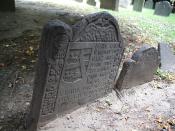The Scarlet Letter: Symbolism of the Nathaniel Hawthorne's letter "A"
The Scarlet Letter includes many profound and important symbols. In "The Scarlet Letter" Nathaniel Hawthorne creates the symbolism of the letter "A" to have different meanings. The "A" is the best example of the symbolism used because of the changes in the meaning throughout the novel. In the beginning of the novel, the scarlet letter "A" is viewed as a symbol of sin. The middle of the novel is a transition period, where the scarlet letter "A" is viewed differently.
When the novel commences, the letter is taken as a label of punishment and sin. Hester Prynne bears the label of the letter upon her chest. She stands labled as an outcast in front of society. She is wearing this symbol to burden her with punishment throughout her life. She stands on a plank where her punishment is given, "'Thus she will be a living sermon against sin, until the ignominious letter be engraved upon her tombstone'"(59).
Society places its blame upon this woman. It is because of this one letter that Hester's life is changed. The letter's meaning in Puritan society banishes her from her normal life. The Puritans view this letter as a symbol of the devil. The letter also put Hester through torture: "Of an impulse and passionate nature. She had fortified herself to encounter the stings and venomous stabs of public contumely
Vaughn2
wreaking itself in every variety of insult but there was a quality so much more terrible in the solemn mood of popular mind, that she longed rather to behold all those rigid countenances contorted with scornful merriment and herself the object"(54). This implies that Hester's sin of bearing a child without the presence of a husband will always be remembered.
In the middle of the novel the letter "A" transitions to a different meaning. In this section of the novel, Hester's appearance is altered to where she is no longer seen as a person of sin. The letter changes from a symbol of sin to a symbol of "Acceeptance". Society now sees Hester as a person who is strong, yet bears a symbol which seperates herself from others. At this point, Hester has learned to deal with the letter. She has grown stronger from it; she is able to withstand the pressures of society. As she grows stronger, she becomes more opposed to being seen as a sinner. The letter's meaning has changed, "Hatred, by a gradual and quiet process, will even be transformed to love, unless the change be impeded by a continually new irritation of the original feeling of hostility"(147). This foreshadows the future events of the novel.
Another view of the letter is that it portrays guilt. It portrays the guilt of Dimmesdale, the father of Hester's child. Hester has learned to deal with her punishment and grow stronger from it, but Dimmesdale, who went unpunished and is a respectable man in the Puritan society, must now live with the guilt of having a child "illegally". This guilt contributes to his weakness as novel
Vaughn 3
continues: "Mr. Dimmesdale was overcome with a great horror of mind, as if the universe were gazing at a scarlet token on his naked breast, right over his heart. On that spot, in very truth, there was, and there long had been, the gnawing and poisonous tooth of bodily pain"(136).
After seven years of torture caused by the scarlet letter, Hester tosses the letter aside for an hour. The return of this letter, however, is beneficial to Hester. The letter's refusal to be swept away, Pearl's refusal to join an unlettered Hester, and Dimmesdale's insistence that Hester do what ever it takes to quiet Pearl, force Hester to reaccept the symbol of the sin she had wrongly divorced, and therefore allow Dimmesdale and Hester to share a mutual public shame. When Hester tosses her sin aside in the forest scene, she is not successful in leaving her sin forever. "The mystic token alighted on the hither verge of the stream. With a hand's breath further flight it would have fallen into the water, and have given the little brook another woe to carry onward . . ." (185). The brook does not carry off Hester's letter, and therefore, the disgrace of her sin is still close by. When Hawthorne says that Hester's new thoughts "have taught her much amiss" (183) he also gives Hester one last chance to reaccept the sin that she has committed and the Puritan Code which she has so strongly rejected. By keeping the letter close at hand, Hester may still return to her rightful place in shame.
The letter affects the child of wedlock, Pearl, also. Pearl immediately
Vaughn 4
recognizes that the letter has been cast aside, and recognizes that in a way she has been cast aside too. Pearl has always been another symbol of the sin between Hester and Dimmesdale, as much, or maybe more than the scarlet letter itself. When Hester removes the letter from her bosom, in Pearl's eyes, she also removes her child. "At length, assuming a singular air of authority, Pearl stretched out her hand . . . and pointing evidently towards her mother's breast. And beneath, in the mirror of the brook, was the flower-girdled and sunny image of little Pearl, pointing her small finger too." (191). This quote symbolizes the two aspects of Pearl both commanding Hester to return the letter to her bosom. The elfish, disobedient Pearl, and the Pearl who creates beauty, both point to their mother in a mixture of shock and disgust. Pearl recognizes the fact that Hester can not toss her sin aside so lightly and makes Hester recognize that fact also.
Also worthy of note, is the fact that Pearl makes Hester pick up the letter and reattach it herself. "'Bring it hither' said Hester. 'Come thou and take it up!' answered Pearl" (193). Pearl wants no part of Hester's sin, and frankly tells Hester so. She knows that the sin of Hester and Dimmesdale can only be borne by them, and reminds Hester of this fact by making her retrieve that which she wrongly threw away. Hester finally perceives this fact, but not in its deeper meaning. "But, in very truth, she is right as regards this hateful token. I must bear its torture yet a little longer - only a few days longer - until we shall have left this region . . . " (193). Hester reattaches the letter, but mistakenly believes that it
Vaughn 5
could ever be fully removed from her. As is seen later in the book. Hester also reattaches this letter in order to pacify Pearl, as requested by Dimmesdale. "'I pray you' answered the minister, 'if thou hast any means of pacifying the child, do it forthwith! . . . I know nothing that I would not sooner encounter than this in passion a child! . . . it has a preternatural effect. Pacify her, if thou loves me!'" (192). The whimpering minister requests Hester to quiet Pearl by refastening the letter of shame on her bosom.
All of these factors demand that Hester take back the symbol of her guilt. By reaccepting this guilt, it gives Hester a chance to become the humble and faithful ultra-Puritan that she was. Hester's reattachment of the letter also allows Hester and Dimmesdale to share their moment of public humiliation together in the market square upon the scaffold. Hester joins Dimmsdale on the scaffold, that in all truth, Hester had been on for seven years. Dimmesdale revels in his dying gasps as he is free from his treacherous sin. "'Is this not better,' murmured he, 'than what we dreamed of in the forest?' . . . (Hester)'Better? Yea' . . . " ( 231). If Hester had not retrieved her letter in the forest, this moment would never have occurred. Hester and Dimmesdale would have run off, but they would never be as close as they are in this scene. This is where the retrieval of the letter helps Hester the most, and it shows how much affect the letter really has on the outcome of the story.
Once the novel nears the end Hawthorne makes the letter "A" "stand for
Vaughn 6
an angel. Hester in the story about this time had more self- esteem and she also looked upon herself as a good person after her sacred love is revealed. So she looks at the "A" lying on her bosom with better thoughts. "The angel and apostle of the coming must be a women, indeed, but lofty, pure and beautiful, and wise, moreover, not through dusky grief, but the ethereal medium of joy" (258). Hawthorne lets us understand that no matter what others think of Hester it does not seem to matter. "So said Hester Prynne, and glanced her eyes downward at the scarlet letter. And, after many years a new grave was delved after a sunken one..."(258). This was an everlasting impression from how the symbolism of the letter that lies on her chest to mean angel, which was the new outlook feeling for her.
From its original symbolic meaning of sin and shame to its ultimate symbol of redemption. The scarlet letter "A" remins the central force of Nathaniel Hawthorne's novel. During the center of the novel the meaning changed and refelcts the changes with the characters. The changes in the "A's" symbolic meaning lets the complicated story unfold around the simple scarlet letter "A".


